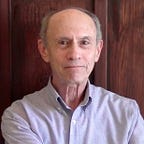LET’S HEAR IT FOR OUR EYES
By Charles E. Kraus
As I begin writing, “let’s hear it for our eyes,” basically celebrating a lifetime of eye treatments that have kept me well focused, I wonder if anyone has ever written, “let’s see it for our ears.” Just a thought.
About 77 years ago, when my eyes first opened for business, the only maintenance they required was blinking often enough to keep them moist. Though it took a while for me to make the connection, I eventually realized that they held proximate responsibility for numerous emotional experiences, not just crying. Seeing something scary such as a ferocious dog, convinced me it would be a good idea to climb a tree. Observing the girl who sat next to me in the third grade, got me goofy. Spotting a piece of chocolate cake — back then, or right now — created/creates a craving. We take in the world through our eyes then our minds decide what to do about the particulars.
The first eye doctor to treat me was my father. He wasn’t really an ophthalmologist, he was an accountant, but he knew a great deal about eyes because he’d read Dr. Bates’ book, Sight Without Glasses, and had a subscription to Science Digest.
If my eyes were red, itchy, felt as though they’d swallowed a sandbox — my father usually diagnosed my condition as a case of sore eyes. He’d get out his eye cup. These gadgets were sold in pharmacies, and therefore seemed to have certain palliative authenticity. They looked like miniature soft boiled egg cups.
Dad would produce the magic ingredient, boric acid, sprinkle some into the cup, add warm tap water, stir until the power had dissolved, request that I lean forward, sore eye down, eye cup up.
I would be instructed to push the devise against my eye socket so that it surrounded the afflicted eye. Returning to upright, the elixir ready to wash away whatever was causing my affliction, I would lean back and open wide. I don’t know what optometrists currently think about this treatment, probably not much, but dad swore by boric acid. According to him, it also cured athlete’s foot.
As I aged, glasses were prescribed. First readers. Then bifocals — reading, walking. Bifocals were allegedly invented by Ben Franklin. As a toddler, I could tell you that Franklin invented lightening. This is what happens when parents spare the rod.
As I aged, the optometrist prescribed progressive lenses. Great for seeing way down the road, the nearby curb, and the map representing the road’s meanderings. Turns out blended lenses are also terrific if you want to be uncertain about where to place your foot when walking down stairs. My orthopedist can tell you more about that.
For many years, family members suggested I look into cataract surgery. I declined on the grounds that, if I was capable of looking into things, then I didn’t need to correct my eye sight. Time passed and all that blurry signage telling drivers the names of places and how many more miles until the next rest stop, became useful information. My urologist can tell you about this.
As I subsequently learned, cataract surgery in laymen’s terms, means paying a lot of money because the insurance company won’t, so an authorized dealer can replace your eyes’ natural lenses with synthetic upgrades. First one eye then two weeks later, the other eye. Limbo is spent comparing right and left visions of your day. Turns out using my uncorrected eye as the control group, I realized I’d been seeing the world through a dull yellow haze. I continued testing one eye against the other until both had undergone the restorative process. Now I open and close both eyes simultaneously, testing, testing, can I see this, can I read that? So far, and I mean really far, so good. You might say I’ve been conducting a double blind study and picturing quite the success.
I see my kids and my grandkids and I feel a certain joy. I see my kids and my grandkids and I think … about the state of the world. The state of the world. I just can’t see it.
